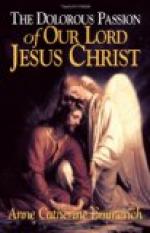Jesus and his companions walked around Mount Olivet, about the valley of Josaphat, and even as far as Mount Calvary. During the whole of this walk, he continued giving them instructions. He told the Apostles, among other things, that until then he had given them his bread and his wine, but that this day he was going to give them his Body and Blood, his whole self—all that he had and all that he was. The countenance of our Lord bore so touching an expression whilst he was speaking, that his whole soul seemed to breathe forth from his lips, and he appeared to be languishing with love and desire for the moment when he should give himself to man. His disciples did not understand him, but thought that he was speaking of the Paschal Lamb. No words can give an adequate idea of the love and resignation which were expressed in these last discourses of our Lord at Bethania, and on his way to Jerusalem.
The seven disciples who had followed our Lord to Jerusalem did not go there in his company, but carried the ceremonial habits for the Pasch to the supper-room, and then returned to the house of Mary, the mother of Mark. When Peter and John came to the supper-room with the chalice, all the ceremonial habits were already in the vestibule, whither they had been brought by his disciples and some companions. They had also hung the walls with drapery, cleared the higher openings in the sides, and put up three lamps. Peter and John then went to the Valley of Josaphat, and summoned our Lord and the twelve Apostles. The disciples and friends who were also to make their Pasch in the supperroom, came later.
MEDITATION VI.
The Last Pasch.
Jesus and his disciples ate the Paschal Lamb in the supper-room. They divided into three groups. Jesus ate the Paschal Lamb with the twelve Apostles in the supper-room, properly so called; Nathaniel with twelve other disciples in one of the lateral rooms, and Eliacim (the son of Cleophas and Mary, the daughter of Heli), who had been a disciple of John the Baptist, with twelve more, in another side-room.
Three lambs were immolated for them in the Temple, but there was a fourth lamb which was immolated in the supper-room, and was the one eaten by Jesus with his Apostles. Judas was not aware of this circumstance, because being engaged in plotting his betrayal of our Lord, he only returned a few moments before the repast, and after the immolation of the lamb had taken place. Most touching was the scene of the immolation of the lamb to be eaten by Jesus and his Apostles; it took place in the vestibule of the supper-room. The Apostles and disciples were present, singing the 118th Psalm. Jesus spoke of a new period then beginning, and said that the sacrifice of Moses and the figure of the Paschal Lamb were about to receive their accomplishment, but that on this very account, the lamb was to be immolated in the same manner as formerly in Egypt, and that they were really about to go forth from the house of bondage.




